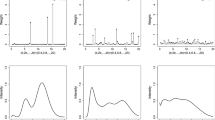Abstract
A new variational Bayesian (VB) algorithm, split and eliminate VB (SEVB), for modeling data via a Gaussian mixture model (GMM) is developed. This new algorithm makes use of component splitting in a way that is more appropriate for analyzing a large number of highly heterogeneous spiky spatial patterns with weak prior information than existing VB-based approaches. SEVB is a highly computationally efficient approach to Bayesian inference and like any VB-based algorithm it can perform model selection and parameter value estimation simultaneously. A significant feature of our algorithm is that the fitted number of components is not limited by the initial proposal giving increased modeling flexibility. We introduce two types of split operation in addition to proposing a new goodness-of-fit measure for evaluating mixture models. We evaluate their usefulness through empirical studies. In addition, we illustrate the utility of our new approach in an application on modeling human mobility patterns. This application involves large volumes of highly heterogeneous spiky data; it is difficult to model this type of data well using the standard VB approach as it is too restrictive and lacking in the flexibility required. Empirical results suggest that our algorithm has also improved upon the goodness-of-fit that would have been achieved using the standard VB method, and that it is also more robust to various initialization settings.
Similar content being viewed by others
References
Aitkin, M., Wilson, G.T.: Mixture models, outliers, and the EM algorithm. Technometrics 22, 325–331 (1980)
Archambeau, C., Verleysen, M.: Robust Bayesian clustering. Neural Netw. 20, 129–138 (2007)
Armstrong, J.S.: Principles of Forecasting. Springer, Dordrecht (2001)
Attias, H.: Inferring parameters and structure of latent variable models by variational Bayes. In: Proceedings of the Fifteenth Conference on Uncertainty in Artificial Intelligence (1999)
Azzalini, A.: Statistical Inference: Based on the Likelihood. Champman & Hall, London (1996)
Balakrishnan, S., Madigan, D.: A one-pass sequential Monte Carlo method for Bayesian analysis of massive datasets. Bayesian Anal. 1, 345–362 (2006)
Ball, G.H., Hall, D.J.: ISODATA, a novel method of data analysis and pattern classification. Stanford Research Institute, Menlo Park (1965)
Beal, M.J., Ghahramani, Z.: The variational Bayesian EM algorithm for incomplete data: with application to scoring graphical model structures. Bayesian Stat. 7, 453–464 (2003)
Beal, M.J., Ghahramani, Z.: Variational Bayesian learning of directed graphical models with hidden variables. Bayesian Anal. 1, 1–44 (2006)
Bishop, C.M.: Pattern Recognition and Machine Learning. Springer, New York (2006)
Brockmann, D., Hufnagel, L., Geisel, T.: The scaling laws of human travel. Nature 439, 462–465 (2006)
Celeux, G., Forbes, F., Robert, C.P., Titterington, D.M.: Deviance information criteria for missing data models. Bayesian Anal. 1, 651–674 (2006)
Celeux, G., Hurn, M., Robert, C.P.: Computational and inferential difficulties with mixture posterior distributions. J. Am. Stat. Assoc. 95, 957–970 (2000)
Constantinopoulos, C., Likas, A.: Unsupervised learning of Gaussian mixtures based on variational component splitting. IEEE Trans. Neural Netw. 18, 745–755 (2007)
Corduneanu, A., Bishop, C.M.: Variational Bayesian model selection for mixture distributions. In: Proceedings Eighth International Conference on Artificial Intelligence and Statistics (2001)
Ester, M., Kriegel, H.-P., Sander, J., Xu, X.: A density-based algorithm for discovering clusters in large spatial databases with noise. In: Proceedings of the Second International Conference on Knowledge Discovery and Data Mining (1996)
Gelman, A.: Bayesian Data Analysis. Chapman & Hall, Boca Raton (2004)
Ghahramani, Z., Beal, M.J.: Variational inference for Bayesian mixtures of factor analysers. In: Advances in Neural Information Processing Systems, vol. 12 (1999)
Gonzalez, M.C., Hidalgo, C.A., Barabasi, A.-L.: Understanding individual human mobility patterns. Nature 453, 779–782 (2008)
Han, J., Kamber, M.: Data Mining: Concepts and Techniques. Morgan Kaufmann, San Francisco (2006)
Jaakkola, T.S., Jordan, M.I.: Bayesian parameter estimation via variational methods. Stat. Comput. 10, 25–37 (2000)
Jain, A., Dubes, R.: Algorithms for Clustering Data. Prentice Hall, Upper Saddle River (1988)
Madigan, D., Ridgeway, G.: Bayesian data analysis. In: Ye, N. (ed.) The Handbook of Data Mining. Lawrence Erlbaum Associates, Mahwah (2003)
McGrory, C.A., Titterington, D.M.: Variational approximations in Bayesian model selection for finite mixture distributions. Comput. Stat. Data Anal. 51, 5352–5367 (2007)
McLachlan, G.J., Peel, D.: Finite Mixture Models. Wiley, New York (2000)
Milligan, G., Cooper, M.: An examination of procedures for determining the number of clusters in a data set. Psychometrika 50, 159–179 (1985)
Richardson, S., Green, P.J.: On Bayesian analysis of mixtures with an unknown number of components (with discussion). J. R. Stat. Soc., Ser. B 59, 731–792 (1997)
Spiegelhalter, D.J., Best, N.G., Carlin, B.P., Van der Linde, A.: Bayesian measures of model complexity and fit. J. R. Stat. Soc., Ser. B 64, 583–639 (2002)
Stephens, M.: Bayesian analysis of mixture models with an unknown number of components—an alternative to reversible jump methods. Ann. Stat. 28, 40–74 (2000)
Svensén, M., Bishop, C.M.: Robust Bayesian mixture modelling. Neurocomputing 64, 235–252 (2005)
Ueda, N., Ghahramani, Z.: Bayesian model search for mixture models based on optimizing variational bounds. Neural Netw. 15, 1223–1241 (2002)
Ueda, N., Nakano, R., Ghahramani, Z., Hinton, G.E.: SMEM algorithm for mixture models. Neural Comput. 12, 2109–2128 (2000)
Wang, B., Titterington, D.M.: Convergence properties of a general algorithm for calculating variational Bayesian estimates for a normal mixture model. Bayesian Anal. 1, 625–650 (2006)
Watanabe, S., Minami, Y., Nakamura, A., Ueda, N.: Application of variational Bayesian approach to speech recognition. In: Neural Information Processing Systems, NIPS 2002 (2002)
Author information
Authors and Affiliations
Corresponding author
Rights and permissions
About this article
Cite this article
Wu, B., McGrory, C.A. & Pettitt, A.N. A new variational Bayesian algorithm with application to human mobility pattern modeling. Stat Comput 22, 185–203 (2012). https://doi.org/10.1007/s11222-010-9217-9
Received:
Accepted:
Published:
Issue Date:
DOI: https://doi.org/10.1007/s11222-010-9217-9




